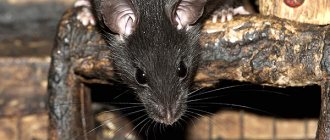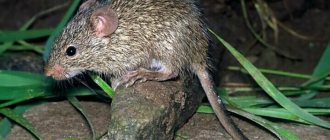Decorative rodents have been living with humans for quite a long time.
Different breeds of rats, or rather their varieties, differ in head and body shape, coat structure and color. Exotic species require special care because they are more vulnerable. It is worth understanding what kinds of decorative rat breeds there are. Let's look at the breeds of rats with photographs and names, and make sure that the fixed mutations are very diverse, for every taste.
Appearance
Outwardly, all rats are similar. However, the black rat differs from the more familiar Pasyuk in several ways:
- Size . Black rats are slightly smaller than their gray relatives. Their body length, depending on gender and age, ranges from 16-22 cm. And their weight ranges from 150 to 300 g.
- Head . The face of black rats is more pointed and extended forward. The ears, on the contrary, are larger and have a rounded shape. The parietal ridges are curved in the shape of an arc.
- The tail is 30-35% longer than the body. On average it reaches a length of 29 cm. Completely covered with hairs.
- Wool . Black rats have soft, shiny fur. Even in older individuals, the fur coat looks quite decent.
It is worth noting that, contrary to their name, representatives of this species are not only black in color. Sometimes there are individuals with white or gray-yellow coats.
Types of rats by body type
There are 3 types of rats based on their build type. Standard are rodents of a familiar species. They have an elongated body, they have a long bare tail of about 20 cm. Like their wild relatives, such rats can weigh up to 0.5 kg and reach 24 cm in length. Rodents have round ears on top of their heads and an elongated snout. The fur of the animals lies tightly to the body, it is smooth and shiny.
The most common type of rats of the standard breed
Dumbo - another variety differs from the standard in ears. They are located not on the top of the head, but on the sides of the head, like the elephant of the same name in the cartoon. Dambo ears are large and open; a slight bend in the upper part of the auricle is allowed. Due to the position of the ears, the head appears wider. The back of the head of these rodents may be slightly convex. The rear of the rat is wider, so the body shape may be slightly pear-shaped.
The round ears of the domestic rat of the Dumbo species give it a special charm
The Manx, a rat without a tail, is classified as a separate species. A rodent needs its tail to cool its body and balance itself. A high proportion of anuran rats have problems with their hind legs and genitourinary system. The birth of cubs is associated with the risk of having a non-viable litter. Sometimes, under the guise of Manx cats, sellers sell ordinary baby rats with their tails amputated after birth. The body of the tailless rat is not elongated, like that of the standards, but in the shape of a pear.
The Manx breed of domestic rats is fraught with many unpleasant surprises.
Important: The tailless rat is a potential handicap, and self-respecting communities do not seek to support this genetic lineage.
Habitat and lifestyle
The black rat is distributed almost throughout the globe, with the exception of abnormally cold areas. The animal prefers habitats with a warm climate. All modern subspecies are believed to have evolved from the most common Asian form.
The most numerous populations are those that inhabit areas near populated areas. Also, the black rat is often called the “ship rat”, since the animal often lives on river and sea vessels. Moreover, on ships the rodent not only looks for food - with their help it spreads throughout the planet.
Like pasyuki, the black rat is nocturnal. Lives in large flocks, in which a clear hierarchy is visible. The leading role is assigned to the dominant male. In natural conditions, they lead a semi-arboreal lifestyle - they deftly climb trees, jump from branch to branch, and build nests in hollows or directly on branches.
Black rats are omnivores, but primarily feed on plant matter. Therefore, they do not have many enemies in their natural environment. Fuzzies can act as prey for owls, snakes or forest cats. In populated areas, the main enemy of black rats can be called humans - people actively destroy the rodents living in their homes.
Unlike their gray relatives, black rats avoid garbage dumps and sewers. Even in human homes, they prefer to occupy the upper tiers - attics and the space under the roof.
Unfortunately, the life expectancy of black rats is very short. In general, the health of black rats is somewhat stronger than that of gray rats. But they die quite early due to the fact that small animals are much weaker than pasyuks, and they are more often exposed to various dangers (predatory animals, unfavorable weather conditions, poor nutrition, injuries from falling from trees).
The vast majority of animals in the natural environment live up to a maximum of 1.5 years. In more comfortable home conditions, under human supervision, a relatively healthy animal can easily live up to 2.5-3 years.
They multiply at an incredible rate
Another type of movie monster is distinguished by the fact that it breeds a population of its own kind at an incredible speed. Usually these are alien creatures who intend to fill the entire Earth with themselves in record time. They may appear as shapeless amoebas made of flesh and teeth that reproduce by division, or as hideous winged monsters that lay eggs in human bodies. One thing is constant - they all multiply very quickly.
This group includes James Cameron's Aliens, John Carpenter's The Thing and... that's right, our rats.
One pair of rodents manages to give birth to up to 6,000 cubs in 2–3 years of their life. Less than three months pass before new offspring also begin to reproduce, and so on. Moreover, it is not customary for them for the younger generation to go to seek a better life in foreign lands. If there is enough food, they will not move until they flood the whole city.
By the way, many regions that skimped on pest control during the recession experienced a real rat outbreak. Britain's rat population now stands at around 80 million, up 200 percent from 2007. And even with all modern methods of rodent control, in New York there is at least one rat per person.
What does a black rat eat?
Under natural conditions, the black rat feeds mainly on plant foods - grass and leaves, nuts, seeds, fruits, and cereals. Among animal foods, it prefers shellfish, insects, and bird eggs.
Recently, the populations of albatrosses and petrels have begun to decline significantly as a result of black rats traveling on ships to secluded islands in the Pacific and Indian Oceans. Scientists have stated that “thanks to” rodents, the number of rare bird species has decreased by almost a third.
Black rats living near populated areas also feed on human food. Some farmers blame rodents for attacking chickens, ducks and destroying birds' nests. An adult requires 15-20 g of food and water per day. It is worth noting that the body of black rats is quite resistant to most poisons.
They were excommunicated...
Once upon a time, these creatures kept towns and cities at bay. In the XIII-XV centuries, they were generally the root cause of death of the population from certain infectious diseases, such as cholera. The famous naturalist Roussenel once compared the invasion of rats with the raids of the hordes of Attila and Genghis Khan.
As soon as humanity did not fight rats. These creatures were destroyed in hundreds and thousands. In the fight against them, people used the most effective poisons, boiling water, fire. It is curious that rats were even excommunicated from the church, calling down a curse from heaven on their entire race! There are about 64 different species of these rodents, but only three are mainly known: the gray, black and white (ornamental) rat.
Reproduction and offspring
The black rat is less fertile than other species. The female brings offspring no more than 5 times a year (and more often - 2-3 times a year), and only in the warm season. At home, of course, reproduction is possible in winter. Puberty in black rats occurs at 3.5-5 months. The gestation period for babies lasts 3-4 weeks. Typically, females give birth to 3 to 12 pups; at home, the fertility rate can increase by 20%. Features of the development of the offspring of black rats:
- are born completely bald, with closed eyes and ears, poorly developed paws;
- after 6-7 days they are covered with “baby” fluff;
- on days 12-14, the eyes open, babies begin to hear;
- by 3 weeks, the formation of all systems and organs is completely completed, the pups begin to slowly leave the family nest.
By the age of one month, the baby rat becomes a smaller copy of the adult. The young begin to feed on their own and explore new territories. It is worth noting that in the natural habitat, all sexually mature females in a flock usually produce offspring at once. Young mothers feed and train their cubs all together.
Odd-eyed rat
This is a very unusual type of rat that has different colored eyes. The most common combination: black, red eye or dark ruby. The value of an animal is determined by the amount of contrast between colors.
The fur of odd-eyed rats can be of any color: gray, brown, black and white, red, blue. Usually, a certain shade of fur corresponds to the color of the eyes: blacks have black eyes, whites have black and red eyes, and blues have ruby eyes. The color of the coat may have spots or streaks.
How does a black rat differ from a gray rat?
Many people understand the word “rat” as the familiar pasyuk, not knowing that this genus of mammals has many species that differ significantly from each other. The main differences between gray and black rats are shown in the table:
| Options | Description | |
| Gray rat | Black rat | |
| Body measurements | 20-25 cm, weight about 500 g | 16-22 cm, weight up to 300 g |
| Color | Grey | Black, grey-yellow, white-yellow |
| Tail | Most individuals are bald, shorter in body | Covered with hair, always longer than the body |
| Nutrition | Mixed, higher in calories | Mostly plant based |
| Intelligence | High | At the highest level - black rats have a good memory, avoid potential danger, and are quickly trained |
| Fertility | High, often the number of rat pups in one litter is 12-20 pcs. | Average - females rarely give birth to more than 12 babies in one birth |
| Habitat | River banks and floodplains, lowlands, holes, basements, sewer hatches | Dry biotopes, trees, attics, roofs |
| Wool | Coarser, lots of guard hairs | Soft, fluffier coat, mostly represented by undercoat |
| Life expectancy (in natural conditions) | On average up to 2 years | 1-1.5 years |
| Aggression level | Tall, often occupy an attacking position | Low, prefer to flee |
| Cannibalism | Distributed | Rarely seen |
Despite their many differences, there are many similarities between gray and black rats. For example, representatives of both species are nocturnal and prefer to rest during the day. Also, both Pasyuki and black rats live in groups in which a clear hierarchy and distribution of roles can be traced.
Description and classification
The taxonomy of the rat places it in the class of mammals, the order of rodents, and the family of mice. Most species have a body size of up to 30 cm and a weight of 30-400 g. The largest rats can exceed this size. They lead a terrestrial lifestyle, some can climb trees, live in burrows alone or in family groups, almost all species are omnivores. Therefore, to the question whether a rat is an animal or not, the answer will only be in the affirmative.
On the territory of Russia, only 3 types of rats live in nature: gray, black and Turkestan. Many species of rats are common in various regions of Asia, America, and Australia. Tree rats live in the forests of North America, the palm rat, which lives on palm trees, is ubiquitous on the Pacific Islands, the Himalayan species lives in China and Vietnam, etc.
In addition to wild rats, there are also domestic species. Breeders have developed many breeds of ornamental rats, which are popular among rodent lovers. Among them you can find animals with and without curly hair, with a flat tail, with fluffy or tailless ones, with large ears, etc. – see photos of rat species.
Types of rats
When asked what color rats are, the answer is that the coat color is very diverse and depends on the breed: gray, black, red, blue, brown, spotted. And some have no fur at all.
Interesting!
In Ancient Egypt, China and Japan, rats lived in temples as sacred animals, which were also used for divination. In Chinese mythology, the rat not only belongs to one of the signs of the Zodiac, but is also endowed with wisdom, is a symbol of prosperity and belongs to the feminine principle “Yang”. In India there is the “Temple of 20 Thousand Rats”, where believers worship rodents, believing that they are inhabited by the souls of the ancestors of Saint Karni Mata.
Black rat - pet
Since the beginning of the last century, rat breeders around the world have made active attempts to domesticate the black rat. However, this problem remains unsolved to this day. Black rats kept in captivity often exhibit behavior typical of wild animals. For example:
- When they see a person, they freeze, hide, hide in a corner of the cage, or, on the contrary, take a militant pose.
- They can attack cage neighbors or the owner for no apparent reason and completely unexpectedly. It would seem that the animal is calmly resting or frolicking, and suddenly, with wild screams, it attacks its opponent.
- They do not show emotional attachment to the owner. It takes a lot of time and patience to tame them. Representatives of this species rarely require attention, do not ask to be held, and do not like to be petted frequently.
At the same time, black rats are very smart; they are superior in intelligence to pasyuks. Therefore, if you have patience, you can easily find a common language with them. Over time, the fluffy will understand that the owner does not pose any danger to him. In addition, there are cases where black rats recognized their owner from the first days and enjoyed spending time with him.
If you still decide to get a black rat as a pet, you will need to listen to the recommendations of experienced rat breeders:
- Black rats, although domesticated, obey primarily natural instincts. Therefore, they will need a more spacious cage with more floors - 5-6 tiers. Representatives of this species lead a semi-arboreal lifestyle, so they will enjoy the opportunity to climb somewhere higher.
- Black rats are more active and mobile compared to their gray relatives. Therefore, to keep the fluffies from getting bored, you will need to equip the cage with a large number of equipment and exercise equipment. For example, ladders, labyrinths, bridges, ropes, running wheels, springboards.
- Black rats have more delicate paws. Therefore, it is better to choose a softer filler for them. For example, paper or corn. But it is better to refuse to install trays in the cage. A freedom-loving black rat is unlikely to go to the toilet in a strictly designated place.
- In the wild, black rats often make nests in hollow trees or on branches. Therefore, in order to bring your pet as close as possible to its natural habitat, you will need to install a cozy house in the cage, and also hang hammocks from the ceiling (on each tier). Small animals will enjoy swinging there.
- Unlike pasyukov, black rats prefer plant foods. Little fluffies should be fed mainly grain, fresh fruits and vegetables, herbs, nuts, and seeds. At the same time, you shouldn’t give up animal protein either. You can introduce some lean meat, fish, seafood, and eggs into your rodent's diet.
- Black rats, like gray ones, are not kept alone. It is better to populate a cage with 3-4 same-sex individuals at once. It should be taken into account that black rats adhere to a clear hierarchy established in the pack. Therefore, at first, animals can begin to sort things out. If the pet's life is not in danger, it is better not to interfere in the conflict. The rodents will distribute roles, and will continue to live in peace and harmony.
- Black rats need to be taught to be handled gradually, using various treats as the main incentive. If the pet does not want to be held, you should not force it, much less shout at it or hit it. It is better to give the animal a little more time to adapt; sooner or later the animal will still get used to its owner.
- It is better not to breed black rats in captivity. Semi-wild animals feel quite uncomfortable in a home environment. Therefore, in most cases, the potential bride and groom are noticeably nervous and, at best, scatter in different corners. At worst, they actively demonstrate aggression towards each other.
In addition, tamed black rats will need to be protected as much as possible from communication with strangers and other stress. For example, from noisy parties, moving, rude attitude.
Owners of other pets (cats and dogs) should avoid purchasing a black rat. A wild animal is unlikely to get along with potential “enemies” in the same territory.
Man's old "friend"
The homeland of the black rat is considered to be East and Southeast Asia, from Vietnam to Afghanistan. It appeared in the Mediterranean and the Middle East back in the Pleistocene era, when mammoths trampled the icy tundra of Yakutia, and Neanderthals ruled the territory of modern Spain, Greece and Italy.
This species was the first to begin to inhabit human housing even when the housing itself was simple huts and caves. And as cities developed, rats became more and more “civilized.”
It was black rats that caused the first outbreaks of the plague pandemic in Europe. In nature, settlements of this species are natural reservoirs of the plague pathogen, from here the animals easily carry plague bacilli into cities. Humans are directly infected with the plague by fleas that have previously bitten sick rats.
In general, the most devastating plague pandemics in medieval Europe arose after the invasion of the Pasyuks. However, the townspeople at that time did not particularly distinguish between these two species, and therefore the more familiar black rats for a long time (if not forever) became a symbol of death, unsanitary conditions and “dark” times.
Before the appearance of pasyuks, black rats were the main pests of agricultural supplies throughout Europe and Asia. In German cities, bonuses were given for the destruction of a large number of these pests; there were even days of prayer for getting rid of rodents.
These measures, however, helped little, and even today, being armed with the most effective poisons and ingenious devices, people only manage to keep the number of rats within certain limits with great difficulty. Much more effectively than all poisons and traps, the black rat is suppressed by its closest relative, the pasyuk.
Interesting facts about black rats
In appearance, black rats are inconspicuous animals that try to show themselves to humans as little as possible. However, the life of these rodents is truly amazing, as evidenced by numerous interesting facts:
- In fact, under the name “black rat” there are 4 different subspecies of rodents. Externally, they are absolutely identical - they have the same size, color and anatomical features. But they have different genetic codes. Representatives of such twin species are quite capable of interbreeding with each other and producing offspring. But the baby rats that are born have poor health and are no longer capable of procreation. It is noteworthy that in the natural environment, representatives of different subspecies live separately from their counterparts.
- Once every 48 years, the “death of bamboo” is recorded in India and China - the area of plant plantations decreases several times. Scientists explain this phenomenon by outbreaks of births among black rats. The rodent population, which has sharply increased in number, begins to actively eat bamboo seeds. Biologists say that from an environmental point of view this is quite normal - rodents thus restrain the excessive growth of bamboo. However, this does not make it any easier for agricultural producers, which is why they are actively fighting the black rat in India and China.
- The black rat populated the planet much earlier than the gray rat. However, due to higher activity and the desire to actively develop new territories, pasyuki gradually replaced these small rodents. In addition, larger gray rats, if necessary, simply devour smaller competitors.
- It was “thanks to” black rats that in the past European countries were subjected to repeated plague attacks. It is this type of rodent that carries the plague bacillus, as well as other pathogens.
- The black rat has a high survival rate. If a predator grabs a rodent by the tail, the thin skin easily peels off, and the rodent has the opportunity to escape. True, after healing the tail has a rather unsightly appearance. Also, a rat can survive without food for 12-14 days. Without water, the fluffy lives half as long.
- In India, there is a temple built 600 years ago in honor of a local saint, which serves as a nursery for black and gray rats. In total there are about 20 thousand animals. Rodents act not only as guests of the temple. It is believed that the souls of relatives of the Hindu goddess live in the bodies of rodents. Therefore, rats are also considered holy and are actively worshiped.
- Since black rats love to travel on ships, spoiling food supplies in the process, sailors have invented a rather cruel way to deal with them. They catch several individuals and put them in a barrel. In conditions of hunger, rats begin to devour each other. When one of the strongest animals remains, it is released. And, obeying the developed instinct of self-preservation, the cannibal rat begins to seek out and eat its relatives.
Before getting an unusual pet, experienced rat breeders advise first finding out everything about black rats - behavior, lifestyle, interesting facts. Then it will be much easier to make a decision. However, those who are truly a fan of these unusual animals are unlikely to be frightened by the difficulties ahead.
Breeds of decorative rats by color
It is customary to divide the colors of rats into several groups.
Homogeneous
The name of the group speaks for itself. All the hairs of the animal are the same color and are evenly colored from root to tip. Uniformly colored rodents include the following colors:
- black;
- blue in different versions;
- mink;
- platinum;
- beige;
- caramel;
- chocolate, etc.
Things like caramel and chocolate aren't even standardized. Rats come in other colors.
Ticked
Ticked colors have uneven colored hair. It is as if divided into sections painted in different colors. At the same time, the guard hairs are monochromatic. Wild rats belong to the ticked group - agouti color. At the base of the back, the hairs are dark gray, higher up there are yellow and orange shades, and the guard hairs are black.
Wild relatives of decorative rats have a ticked agouti color
Agoutis can be blue, platinum or amber. In blues, the coat changes from light gray to brown with light blue guard hairs. Platinum fades from light blue to cream. Amber has a transition from light orange to silver beige.
Among the ticked type there are also red representatives of decorative rodents.
The color of the fawn is distinguished by a bright orange color. The base of the hair is gray or blue, but then there is a rich red tint. Interspersed with silver guard hairs do not change the overall picture. The ticked group also includes different pearl colors of rodents.
Silver
Silver color is determined if the number of white - silver hairs is equal to the number of homogeneous ones. The animal's coat should sparkle. If there are few white hairs, then this effect will not occur. The end of the white hair may have a different color, this is allowed. The main thing is that the white wool is in sufficient quantity and mixed with a uniform tone to create shine.
A decorative rat is classified as silver if its skin is shiny
Combined
The color is a combination of two primary colors. The combined type includes Siamese and Himalayan colors, Burmese and Burmese colors. English version of the name Point. Darker points follow the main color.
Combined color involves a combination of 2 colors
Preliminary control of rats, damage from rodents
Preventive measures to control rats
Since rodents are active throughout the year, it is necessary to periodically check for signs of their presence. If rodents have infested your garden or lawn but have not yet entered your home, then it is only a matter of time, and if you do not take measures to combat rats, they will definitely appear in your home. Experience shows that the sooner you start exterminating rats, the less effort will be spent on installing baits and rat traps.
Conduct a thorough inspection of the home and surrounding areas. If you do not know and do not want to take measures to exterminate rats yourself, then you should contact professionals from specialized companies involved in the extermination of rats. If you detect at least one of the following signs, your home is probably infested with rodents, and then rat control is inevitable.
- Is there rat feces near dog and cat feeders or food bags?
- You can hear rustling or scratching noises in the attic in the evening or at night.
- The woodpile contains the remains of rat nests. After this, you should immediately set traps to kill rats.
- A dog or cat brought a dead rodent into the house.
- Nibbled fallen apples or other garden fruits were found on the ground in the garden or in the house (on the terrace).
- Among the plantings there are holes and bitten vegetables.
- You may notice rodents running across garden paths or sitting at dusk (or near-darkness) on the tops of a picket fence.
- Rats' nests are found in unattended cardboard boxes or table drawers in a barn or woodshed. In these places you can place poisonous briquettes to fight rats.
- You can find rodent hair left behind by rubbing against rafters, beams, and chimneys in the attic.
- Burrows are visible under compost heaps or under garbage cans.
- Rat feces were found in the kitchen trash can.
- A dead rodent floats in a garden pond or water collection tank.
- Under the woodshed or doghouse, there are clearly visible tunnels.
The main independent measure to combat rats is the installation of rat traps. You will find information on methods of placing rat traps in the article “ Basic aspects and devices for fighting rats .”
Harm from home infestation by rats
Rodents eat spoiled food and pet food. They make holes in containers and packaging materials containing food and feed. Both types of rats gnaw electrical wires, wooden objects - doors, planks, slats, corners and wall materials, they tear insulation in walls and ceilings in order to make a nest. Establishing nesting sites will help in organizing rat control.
With their burrowing activity, gray rats can dig through the foundations of buildings and foundation slabs, and can chew all types of materials, including soft metals such as copper and lead, as well as plastic and wood. As for the black rats that occupy the upper levels of buildings, they cause significant damage by gnawing on everything to build their nests. They also spoil garden crops and ornamental plantings. Therefore, the fight against rats also preserves the plantings.
Among the diseases transmitted by rodents to humans or domestic animals are endemic rat typhus (rat rickettsiosis), salmonellosis (food poisoning), leptospirosis, sodoku (rat bite disease), and plague.











